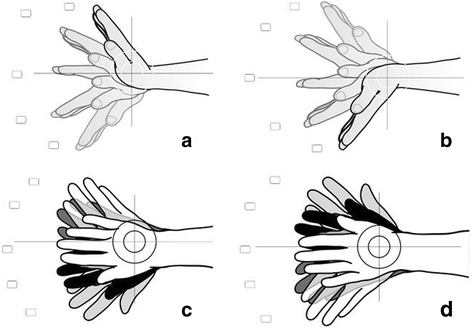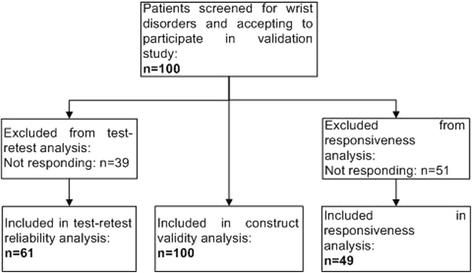The Munich Wrist Questionnaire (MWQ) - development and validation of a new patient-reported outcome measurement tool for wrist disorders
- PMID: 27079377
- PMCID: PMC4832466
- DOI: 10.1186/s12891-016-1029-4
The Munich Wrist Questionnaire (MWQ) - development and validation of a new patient-reported outcome measurement tool for wrist disorders
Abstract
Background: Although self-assessment questionnaires for the wrist joint are numerous, most validation studies focus on a specific pathology and patient collectives. In addition the available questionnaires focus on subjective parameters such as pain, usual and specific activities but the range of motion (ROM) as an essential objective parameter in wrist disorders is rarely considered. Therefore the purpose of the presented study was to develop and validate a new universally applicable self-assessment score, the Munich Wrist Questionnaire (MWQ), which allows for the assessment of subjective as well as objective parameters of the wrist joint.
Methods: The MWQ consists of 16 items addressing three domains: pain, work and activities of daily living and wrist function including range of motion and grip strength. In a prospective clinical study validity, reliability and responsiveness of the MWQ of physical active patients were evaluated.
Results: Validation study included 100 patients (mean age 41 years, SD 16.3 years; range, 18-77 years). Test-retest reliability was substantial, with intraclass correlation coefficients ranging from 0.75 to 0.83 for the three domains. Construct validity and responsiveness were confirmed by correlation coefficients of at least 0.86 for construct validity and for responsiveness ranging from 0.61 to 0.65.
Conclusions: The MWQ presents a valid and reliable instrument for a qualitative self-assessment of subjective and objective parameters (e.g. range of motion) of the wrist joint. Quantitative measurement of wrist function may not longer be limited to specific wrist disorders or patient groups. The MWQ seems to allow for a broad application in clinical research and may facilitate the comparison of treatment results in wrist disorders.
Keywords: MWQ; Outcome measurement tool; Reliability; Responsiveness; Validity.
Figures




References
-
- Capuano L, Poulain S, Hardy P, Longo UG, Denaro V, Maffulli N. No correlation between physicians administered elbow rating systems and patient’s satisfaction. J Sports Med Phys Fitness. 2011;51(2):255–259. - PubMed
-
- Hudak PL, Amadio PC, Bombardier C. Development of an upper extremity outcome measure: the DASH (disabilities of the arm, shoulder and hand) [corrected]. The Upper Extremity Collaborative Group (UECG) Am J Ind Med. 1996;29(6):602–608. doi: 10.1002/(SICI)1097-0274(199606)29:6<602::AID-AJIM4>3.0.CO;2-L. - DOI - PubMed
Publication types
MeSH terms
LinkOut - more resources
Full Text Sources
Other Literature Sources
Medical

